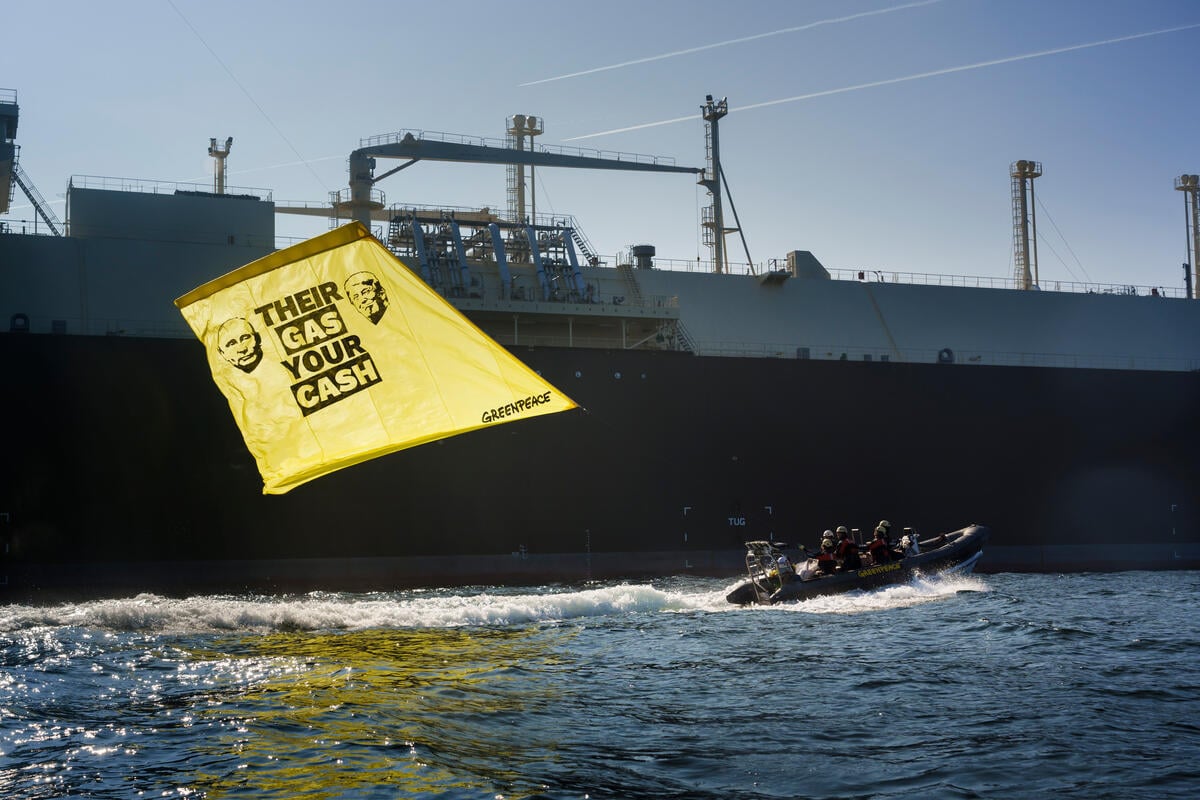Belgium – Today, eight activists from Greenpeace Belgium confronted an LNG tanker coming from the US, and heading for the port of Zeebrugge, in protest of Europe’s continued dependence on fossil gas imports. Aboard the Arctic Sunrise and in inflatable boats, they approached the US Marvel Swallow and unfurled banners featuring Trump and Putin, and reading “Their gas, your cash” to denounce how Europe’s reliance on fossil gas fuels geopolitical instability, while leaving households burdened with skyrocketing energy costs.
Campaigners urge Europe to become energy independent by transitioning to renewables. Ending fossil gas imports is crucial for safety and security, says Greenpeace.
Photos and videos are available in the Greenpeace Media Library.
On board the Arctic Sunrise, Joeri Thijs, spokesperson for Greenpeace Belgium, said: “Autocrats like Putin fund their wars with gas revenues, while political bullies like Trump use their dominance as gas suppliers to pressure European countries economically and politically. Meanwhile, families and communities struggle with soaring energy bills and extreme weather fuelled by fossil gas. This dependence leaves us all vulnerable. Energy sovereignty through renewables is no longer just an environmental necessity, it is a matter of security.”
On March 26, the EU implemented a ban on transshipment of Russian gas (LNG) at European ports. This ban is part of the EU’s 14th sanction package against Russia and is aimed at restricting Russian LNG exports.[1] But despite promises to cut ties with Russia, EU imports of Russian LNG rose by 18% in 2024, and 45% of total imported LNG came from the US in the same year, making the US and Russia the EU’s first- and second-largest LNG suppliers.[2] In total, the bloc spent €21.9bn on Russian oil and gas, surpassing the €18.7bn in aid to Ukraine, while delays persist in phasing out Russian fossil fuels imports.[3] And as Trump is pushing for Europe to buy more US fossil gas, leading EU officials are actually considering increasing US LNG imports.[4]
Thomas Gelin, energy and climate campaigner at Greenpeace EU, said: “The EU’s dependence on fossil fuel imports, with all the problems that brings, can’t be broken without a wholesale move to renewable energy and a clear commitment to phase out all fossil fuels, including fossil gas. The first step must be an immediate ban on all new fossil fuel projects in the EU, it’s senseless to prepare for more fossil fuels than we need. No new pipelines, no new gas terminals, no half-measures: a ban on all new fossil fuel projects, pure and simple.”
Breaking free from fossil gas is crucial for tackling the cost-of-living crisis, protecting democracy, and defending human rights. With Europe’s LNG imports declining and gas demand down 20% since 2021, the EU must accelerate this shift. Greenpeace urges a full phase-out of fossil gas by 2035 and a commitment to clean, independent energy.[5]
ENDS
Photos and videos are available in the Greenpeace Media Library.
Notes:
Expedition across Europe rallies support to wean the continent off fossil gas
This protest took place as Greenpeace’s Fossil-Free Future campaign carries out its ‘Stop Fossil Gas’ expedition across Europe. This year, the campaign is visiting several European countries aboard the iconic Arctic Sunrise to spark debate about Europe’s energy system; question its dependence on fossil gas; and promote a just and fair phase-out of fossil gas through a transition to renewable energy that allows everyone to meet their energy needs at a decent price, without harming people, the planet or the environment. Greenpeace is gathering support for a ban on all new fossil gas -and fossil fuel- infrastructure projects in the EU. Its Open Letter to the EU and national governments has already gathered 80.000 signatures.
[1] Transshipments of Russian LNG occur when LNG cargoes from the Yamal peninsula in Russia arrive at an LNG terminal in Europe and are transferred from icebreaker carriers to conventional LNG carriers. The LNG is then sent to third markets, with European countries facilitating the sale of Russian LNG. Transshipments of Russian LNG from Yamal take place in two European ports: Zeebrugge in Belgium and Montoir-de-Bretagne in France. Experts have raised concerns that this ban could result in increased imports of Russian LNG to Europe.
[2] According to IEEFA’s recent update of its LNG tracker, EU imports of Russian LNG increased by 18% in 2024, and 45% of LNG imported to the EU in 2024 came from the US. With Russian LNG flows at record levels, Russia overtook Qatar as Europe’s second-biggest supplier of LNG, behind the US, recent data from Rystad Energy show.
[3] EU imports of Russian fossil fuels in third year of invasion surpass financial aid sent to Ukraine, according to a recent study from the Centre for Research on Energy and Clean Air. Last week, the EU Commission postponed its roadmap to phase out Russian fuel imports from March 26 to an unknown date.
[4] Both industry and leading EU officials, including European Commission President Ursula von der Leyen, have recently suggested increasing US LNG imports to the EU to further reduce dependency on Russian gas and as a bargaining chip to appease Trump and avoid looming US import tariffs on EU goods.
[5] IEEFA’s European LNG Tracker
Contacts:
Manon Laudy, Press Officer, Fossil-Free Future Campaign, Greenpeace Netherlands, +336 49 15 69 83, [email protected]
Greenpeace International Press Desk, +31 (0)20 718 2470 (available 24 hours), [email protected]
Source link
Greenpeace International www.greenpeace.org

